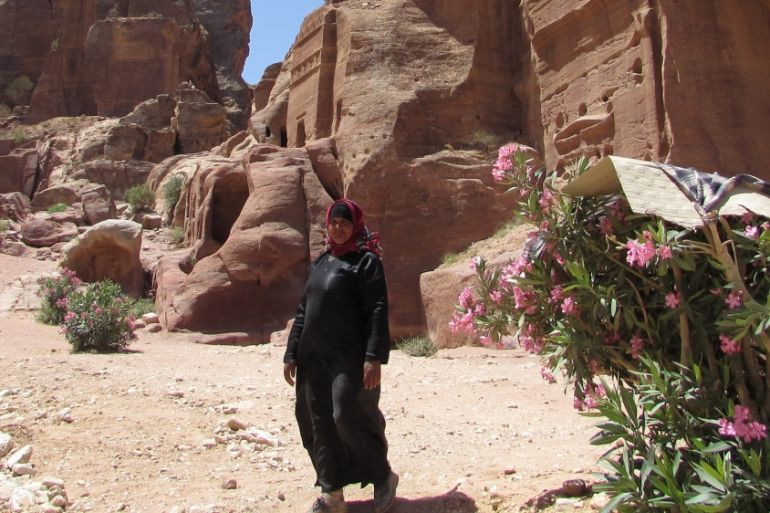Jordan’s ISIL campaign scares away tourists
Tourism to the kingdom is plunging, leading Jordan’s government to adopt an “emergency plan” to revive the sector.

Wadi Rum, Jordan – Shaker al-Onaizi started his career in tourism at the age of five by selling postcards to tourists who flocked to the desert expanse of Wadi Rum in southern Jordan.
Now the 24-year-old, like tens of thousands of other Jordanians who rely on tourism for their living, is facing his leanest year. Campsites are empty, and his 4×4 pick-up truck, which once took dozens of visitors on guided tours each day, sits idle.
Keep reading
list of 4 itemsA flash flood and a quiet sale highlight India’s Sikkim’s hydro problems
Why is Germany maintaining economic ties with China?
Behind India’s Manipur conflict: A tale of drugs, armed groups and politics
“If there are tourists, we work and eat. If not, we sleep,” Onaizi said as he gazed across the reddish desert.
While tourism in Jordan has been on the decline since the outbreak of the Arab Spring uprisings four years ago, it has witnessed its sharpest drop in 2015, with the number of tourists in the first four months of the year down 40 percent from 2014.
The tourism sector makes up 13 percent of Jordan’s gross domestic product, and provides jobs in hotels and resorts for around 49,000 people. This figure excludes members of local communities – Bedouins in Petra and Onaizi in Rum – whose livelihoods are based on tourism.
RELATED: Father of murdered Jordan pilot demands revenge
Officials and experts in the sector attribute the decline to Jordan’s prominent role in the campaign against the Islamic State of Iraq and the Levant (ISIL). “We are paying a tax for being in the middle of an inflamed region,” said Abul Razaq Arabiat, the head of Jordan’s Tourism Board.
In December, ISIL downed a Jordanian jet and captured its pilot, Moaz al-Kasasbeh, in the Syrian city of Raqqa. In February, ISIL released a video showing the pilot being burned alive, sparking angry protests across Jordan calling for revenge and increased Jordanian air strikes against the group in Syria.
Instability around us will remain our biggest challenge.
Tourism industry leaders say the worldwide publicity created by these events scared off thousands of tourists, prompting tour groups to cancel their bookings to the kingdom.
“The pilot crisis created a perception that Jordan is not safe,” said Lina Khalid, director of the Jordan Inbound Tour Operators Association.
The capture of the pilot happened at around the same time as the Charlie Hebdo attacks in Paris, which Khalid believes also caused thousands of cancellations.
“Many French tourists were worried by demonstrations against the cartoons that took place in Jordan,” she told Al Jazeera.
Late last year and early this year, the US and French embassies in Jordan issued travel warnings, asking their citizens to be cautious and to stay away from malls and shopping centres in the country. The travel warnings have “discouraged many Westerners” from visiting Jordan, according to Arabiat.
The drop in tourists is most noticeable in what is known as Jordan’s “golden triangle” of tourism: the sites of Wadi Rum, Petra, and Aqaba.
According to Khalid, occupancy of hotels in the region has not exceeded 20 percent so far this year, whereas normally occupancy rates can reach 90-95 percent.
The ancient city of Petra is nearly empty; on one day in early June, just a few dozen tourists wandered its cavernous gorges and rock-carved temples. Out of desperation, children clung to the occasional visitor who passed by, trying to sell them postcards.
![Tour guide Onaizi says he may have to abandon the tourism sector [Areej Abuqudairi/Al Jazeera]](/wp-content/uploads/2015/06/e2eff368cb50458c9690b59c162d3f60_18.jpeg)
Bedouin men and women advertised 50-percent-off sales on silver and antiques, while young men strolled back and forth, treading the same dusty paths with their horses and camels, trying to convince the handful of visitors to take a guided tour.
In Petra alone, 10 hotels have been reported closed this year due to mounting losses, and many have reduced their staff, leaving hundreds of residents jobless.
In Rum village, which has a population of roughly 1,300, people rely mainly on tourism as a source of income, while others work in the military or herd animals.
Onaizi, the tour guide, who dropped out of school at the age of 14 to help his father open one of the area’s first campsites, said that unless the industry rebounds soon, he and many of his peers will abandon the sector.
“I have been engaged for a year and a half, and I do not know how long it will take me to build my future home,” said Onaizi. In previous years, his camp used to host up to 30 or 40 people a night; now, barely a handful trickle in each week.
RELATED: Jordan concerned about growing support for ISIL
In recent weeks, the Jordanian government announced that it was taking measures and adopting an “emergency plan” to address the challenges facing the country’s tourism sector.
The measures include waiving the $56 visa fee for visitors staying in the country for a minimum of two consecutive nights, and introducing a new, $100 “all-inclusive” pass for the country’s most famous tourist sites, such as Petra, Jerash, and the site where Jesus is believed to have been baptised. Currently, the entry fee to Petra alone is $70.
Jordan’s Ministry of Tourism declined Al Jazeera’s repeated requests for an interview on the topic.
But it remains to be seen whether these measures will be enough to counter potential tourists’ security concerns.
“Instability around us will remain our biggest challenge,” Arabiat said. “Until the regional turmoil calms down, we have to tell the world that Jordan is safe.”